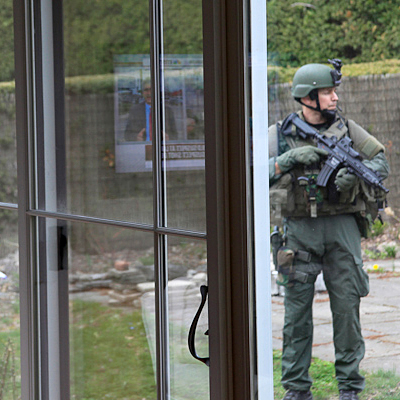In Boston, An Exercise in Intimidation
In the aftermath of the Boston Marathon bombing, why did so few people protest the decision to lock down parts of the city?
I remember the afternoon of Nov. 22, 1963, as if it were last week, but until I heard the news of the Boston Marathon bombing and its aftermath, I had forgotten several of that November day’s salient details. About the same time my grammar-school principal, Marshall Benjamin, gathered us to announce the shooting of President Kennedy, Lee Harvey Oswald was fleeing the scene of his crime — in a municipal bus, a taxi, and on foot through the busy streets of Dallas. Sought by the police (since he was the only employee of the Texas School Book Depository missing from work), he killed an officer who tried to question him and eventually took refuge in a movie theater. Thanks to an alert shoe-store manager, who had noticed Oswald sneaking into the Texas Theatre without buying a ticket, the police were called.
Oswald was apprehended after briefly watching War Is Hell — an out-of-competition selection for the 1961 Cannes Film Festival — but not before he tried to shoot the arresting officer with a pistol from his seat in the back of the cinema. Less than an hour and a half after the president was shot, Kennedy’s assassin was in custody, and very much alive for questioning.
I relate these incidents to emphasize the differences between the respective manhunts in Dallas and in Boston, nearly fifty years later. Comparisons may be odious, but in this case they usefully highlight how much America has changed, and for the worse, since Kennedy was murdered — but also since 9/11.

New Hampshire State trooper canvassing a neighborhood in Watertown, Mass. Photo by Sally Vargas/ Talk Radio News Service
How is it that much of an urban area of several million people could be shut down for nearly an entire day with so few people protesting an essentially military decision by civilian officials? Unlike the conspiracy theorists who will doubtless dispute my Oswald narrative, I’m not suggesting that Governor Deval Patrick planned to seize power and name himself king of the Commonwealth of Massachusetts. But I still haven’t heard a convincing argument that confining people to their homes in Watertown, Cambridge, and Boston led the police any faster to the capture of Dzhokhar Tsarnaev. On the contrary, it wasn’t until the lockdown was lifted that David Henneberry went outside, noticed that his boat cover was stained with blood, and called the police.
Perhaps the political differences between 1963 and 2013 are so obvious that I shouldn’t make the point that the non-shutdown of Texas’s second-largest city — buses, taxis, pedestrians, and cinephiles continued to circulate — in no way impeded the rapid arrest of a fugitive assassin who shocked the country to its core. I understand the fear of unexploded bombs; I sympathize with the victims. But there was something terribly wrong with the government’s response to the bombing.
In Boston, as in Dallas, a law-enforcement agent (Massachusetts Institute of Technology police officer Sean Collier) was apparently killed by an assassin after the initial crime was committed and the public terrorized. Nevertheless, in Dallas, the National Guard was not mobilized, and armored vehicles did not parade around Dealey Plaza.
As Emilo Viano, of the Department of Justice, Law and Society at American University, noted on Quebec radio, the massive, disproportionate show of force in Boston “was practically a military exercise” that “demonstrated more a wish to see what nowadays can be done through cooperation by federal, state and local police with the military.” In short, it was a tactical operation designed more for the symbolic value of its intimidation than to catch the killers.
But who in public life dares to say such things in the midst of a terrorist “crisis,” when everyone seems impressed by the sight of massed men in uniform. Only the marginalized seemed up to the task. Take Ron Paul, who denounced a “military-style occupation” and “police-state tactics.” Meanwhile, Ralph Nader correctly pointed out how discordant it must seem to foreigners to see “a great city in total lockdown . . . when Iraqis, Afghans, Pakistanis, and Yemenis experience far greater casualties and terror attacks several times a week.” For Nader, the lesson to be drawn from Boston by angry Muslims overseas “is that, until now, the high-tech buttons were only being pushed by the drone operators against them. After Boston they can see that other low-tech buttons can now be pushed inside the U.S. against defenseless gatherings of innocent people.”
Further, the show of force in Boston does two destructive things: First, it feeds the paranoia of the National Rifle Association, and gun militants in general, and encourages them to stockpile even more weapons. In the wake of the Boston bombings, has the fight for stricter control of firearms been advanced? Has anyone dared call for limits on fireworks purchases?
Second, and probably worse, Governor Patrick has signaled future terrorists that when they attack American targets they will likely get twice the bang for their buck. Not only will they kill and maim innocents in the immediate vicinity of the bombs; they’ll have the added satisfaction of seeing millions of free people cowering far from the scene of the crime.


